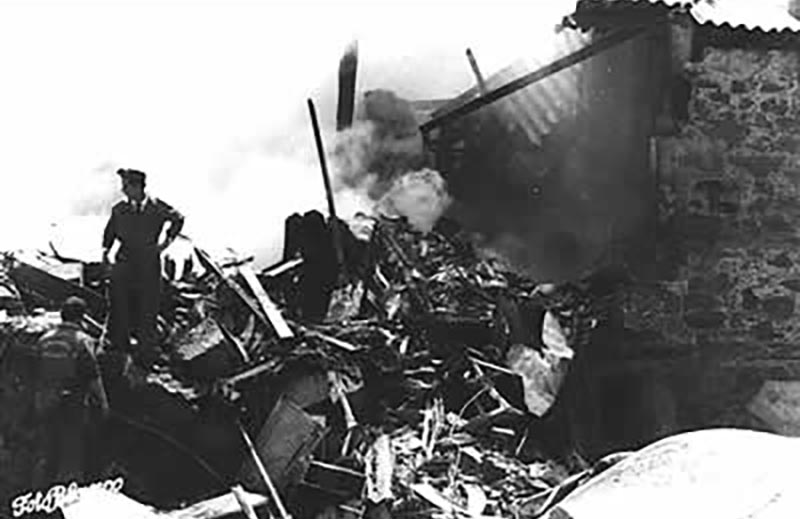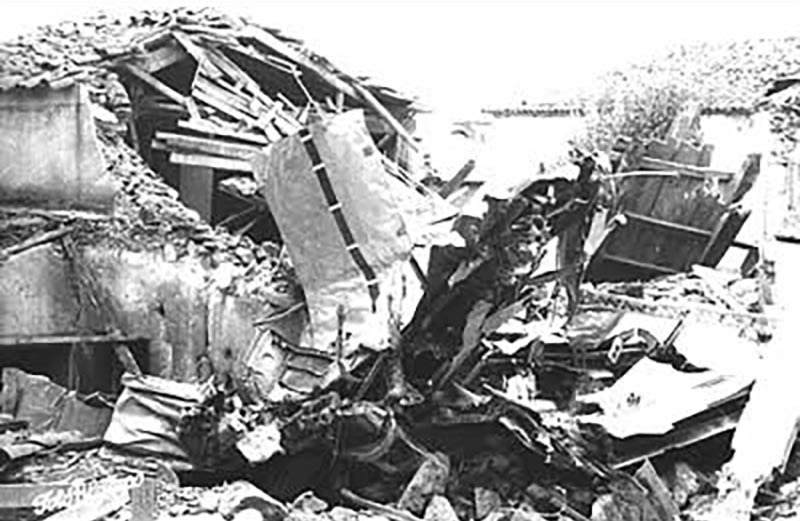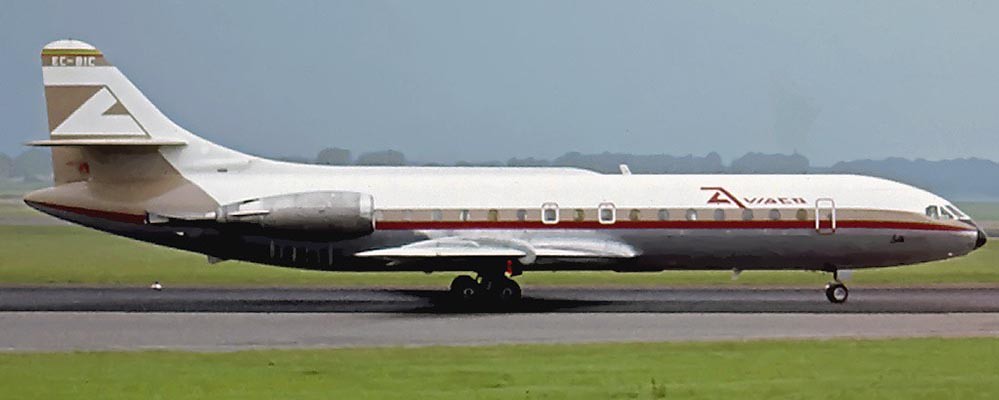Montrove, the data from the report of the worst air accident in the history of Galicia
On August 13, 1973, 50 years ago, Galicia experienced the worst plane crash in its history, which occurred in Montrove, near La Coruña.
That day, a Sud Aviation SE-210 10R Caravelle turbojet from the Spanish company Aviaco, with EC-BIC registration, construction number 225 and named "Emilio Arrieta", in honor of the Navarrese composer. According to Aviation Safety, the aircraft made its first flight on June 19, 1967. It was purchased by Iberia and was initially leased by Aviaco in March 1972, which finally purchased the aircraft on May 17 of that year.

According to Bureau of Aircraft Accidents Archives, Aviaco flight AO-118 took off from Barajas Airport, in Madrid, at 08:30 GMT (09:30 Spanish peninsular time) to Alvedro Airport, in La Coruña. It had 6 crew members and 79 passengers on board. At 09:14 GMT the plane made contact with the La Coruña tower and was informed that the weather at the airport was below normal. minimum, due to the fog.
At 09:21 GTM, the La Coruña tower informed EC-BIC that visibility at the airport was only 350 metres. The aircraft was then at an altitude of 3,000 feet (914 meters), starting the approach. At 09:23 GTM the tower reported a visibility of 600 metres. A minute later, the EC-BIC pilot reported that he would attempt to land. The plane was then at 2,200 feet (670 meters).

At 09:28 GMT the tower reported a visibility of 800 metres, but with a light breeze that caused the fog to close in again from the sea. As the ground was not visible, the first approach was frustrated and the aircraft went into a holding position at 6,000 feet (1,828 meters). At 09:34 GMT, the tower reported a visibility of 400 meters. At 09:36 GTM the aircraft had already started a second approach, but the tower warned that there was accumulated fog at the runway threshold. The second approach was aborted and the aircraft returned to a holding situation.
At 10:20 GTM, the tower reported an improvement in weather with a horizontal visibility of 1,500 meters and a vertical visibility of 150 meters, which improved to 250-300 meters three minutes later. At 10:32 GMT the pilot reported the discontinuation of the third approach At 10:38 GMT, the pilot reported the start of a fourth approach. At 10:39 GTM the pilot asked the tower about the state of the wind, and they answered that it was completely calm. The pilot confirmed the approach and from the tower they replied that they were waiting to see a plane. At 10:40 GMT the last message from the EC-BIC pilot arrived: "Roger" (received). Then there was silence.

At 10:41 GMT, the tower reported that the wind was increasing slightly, but received no response, despite successive attempts to communicate with the aircraft. At 10:46 GTM, the tower was informed by the airport manager that the plane had crashed in Montrove, in the town of Oleiros (La Coruña), 3 kilometers from runway 22 from Alvedro Airport, at coordinates 43º18'N 08º23'W. The accident took place at approximately 10:40 GMT, 11:40 local time.
300 meters from the place where the wreckage appeared, the plane knocked down three eucalyptus trees and cut off the tops of 23 more. The aircraft's right stabilizer was found embedded in trees. The plane was embedded in the roofs of three houses on the Pazo del Río estate, in Oleiros.

Due to the impact, the cabin, which did not catch fire, was separated from the fuselage, remaining 10 meters from the rest of the plane. The aircraft's left stabilizer and rear cone were torn off. The left stabilizer was 10 meters from the aircraft and the right landing gear was 50 meters away. Due to the impact, the fuselage registered three minor explosions and caught fire, being destroyed. The fire was quickly brought under control by firefighters.
The report of the General Directorate of Security on the accident was declassified 41 years later, in 2014. Due to the fact that in 1973 there were no DNA tests, many of the corpses could not be identified and ended up in a common grave in the San Amaro cemetery, in La Coruña. Those buried without a name took 40 years to be identified. The latest report on the bodies collected at the scene of the accident indicated the following: "82 bodies have been recovered from the plane crash, distributed as follows: females: 22; males: 34; Boys: 3; Girls: 5; Unidentified: 18".

There was only one survivor of this accident, who was taken to the Juan Canalejo Hospital in La Coruña, where he died a few hours later. In addition, a worker who was working in the area where the accident occurred. The misfortune could have been greater, since the plane destroyed two houses, but both were uninhabited.
The official report of the International Civil Aviation Organization (see PDF) stated that the plane was flying very low and at a low speed when the right stabilizer collided with the eucalyptus trees. The pilot probably tried to accelerate to avoid the collision, but it was too late. The report indicated the following as the probable cause of the accident: "Infringement by the pilot of the rules and instructions that govern the flight over national territory, and of the international rules in force in Spain."

At the time of the accident, the EC-BIC commander had accumulated 304 flight hours in Caravelle and 8,610 flight hours in total. The co-pilot had 997 flight hours in Caravelle and 6,283 flight hours in total. The EC-BIC had accumulated 13,118 flight hours and 9,380 landings. The aircraft was in good condition. The Caravelles were operated by Aviaco as a temporary solution pending receipt of the more modern McDonnell Douglas DC-9s.

The EC-BIC accident was not the only accident the company had with these planes. A few months earlier, on March 5, 1973, Aviaco had lost another Caravelle, the EC-BID "Tomás Bretón", in an accident in which its three crew members died, during a positioning flight.
At that time, airlines gave financial incentives to pilots who made landings in risky weather conditions to avoid having to divert to another airport, which implied additional expenses for companies by having to provide ground transportation passengers to the destination airport. The Montrove accident served to put an end to that practice.
---
Main photo: Udo K. Haafke.
|
Don't miss the news and content that interest you. Receive the free daily newsletter in your email: |
- Most read
- The 'hole' without civil flights around Paris during the opening of the Olympic Games
- Stunning footage of the F-15QA Ababil in flight recorded from its cockpit
- The firearms used by the Pontifical Swiss Guard, the smallest army in the world
- This is the driver station of an M1 Abrams tank and the impressive start of its engine
- The first photo of an F-16 fighter with Ukrainian insignia and the details it has revealed
- Eurofighter vs F-35: the opinions of professional pilots on these advanced fighters
- The new CADPAT (MT) digital camouflage of the Canadian Armed Forces

 ES
ES







Opina sobre esta entrada: